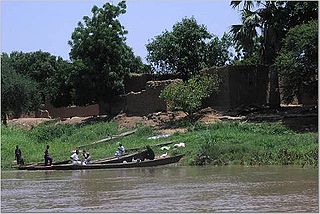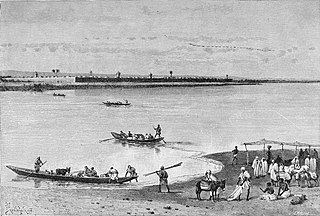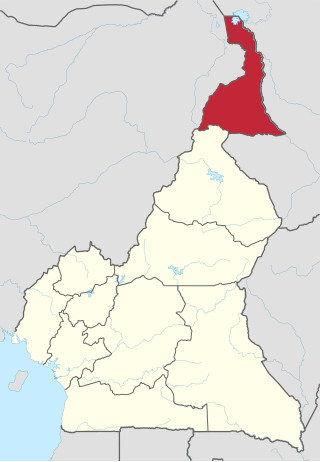
Transport infrastructure within Chad is generally poor, especially in the north and east of the country. River transport is limited to the south-west corner. As of 2011 Chad had no railways though two lines are planned - from the capital to the Sudanese and Cameroonian borders during the wet season, especially in the southern half of the country. In the north, roads are merely tracks across the desert and land mines continue to present a danger. Draft animals remain important in much of the country.

The Chari River, or Shari River, is a 1,400 kilometres (870 mi) long river, flowing in Central Africa. It is Lake Chad's main source of water.

The Biu–Mandara or Central Chadic languages of the Afro-Asiatic family are spoken in Nigeria, Chad and Cameroon.

The Adamawa Region is a constituent region of the Republic of Cameroon. It borders the Centre and East regions to the south, the Northwest and West regions to the southwest, Nigeria to the west, the Central African Republic (CAR) to the east, and the North Region to the north.

The Sultanate or Kingdom of Bagirmi or Baghermi was an Islamic sultanate southeast of Lake Chad in central Africa. It was founded in either 1480 or 1522 and lasted until 1897, when it became a French protectorate. Its capital was Massenya, north of the Chari River and close to the border to modern Cameroon. The kings wore the title Mbang.

The Logon or Logone River is a major tributary of the Chari River. The Logone's sources are located in the western Central African Republic, northern Cameroon, and southern Chad. It has two major tributaries: the Pendé River in the prefecture Ouham-Pendé in the Central African Republic and the Mbéré River in the east of Cameroon. Many swamps and wetlands surround the river.

Borno State is a state in the North-East geopolitical zone of Nigeria. It is bordered by Yobe to the west for about 421 km, Gombe to the southwest for 93 km, and Adamawa to the south while its eastern border forms part of the national border with Cameroon for about 426 km. Its northern border forms part of the national border with Niger for about 223 km, mostly across the Komadougou-Yobe River, and its northeastern border forms all of the national border with Chad for 85 km ,.It is the only Nigerian state to border up to three countries. It takes its name from the historic emirate of Borno, with the emirate's old capital of Maiduguri serving as the capital city of Borno State. The state was formed in 1976 when the former North-Eastern State was broken up. It originally included the area that is now Yobe State, which became a distinct state in 1991.

Kousséri, founded and known as Mser in the indigenous Mser language, is a city in Far North Province, Cameroon. It is the capital of the Logone-et-Chari department. It is a market town, and its population has recently been swollen by refugees from Chad. It had a population of 89,123 at the 2005 Census. The majority of the population are Shuwa Arabs with Chadian Arabic used as the lingua franca.

The Kirdi are the many cultures and ethnic groups who inhabit northwestern Cameroon and northeastern Nigeria.

The Far North Region, also known as the Extreme North Region, is the northernmost and most populous constituent province of the Republic of Cameroon. It borders the North Region to the south, Chad to the east, and Nigeria to the west. The capital is Maroua.
The Kotoko kingdom was an monarchy in what is today northern Cameroon and Nigeria, and southwestern Chad. Its inhabitants and their modern descendants are known as the Kotoko people.

Rabih az-Zubayr ibn Fadl Allah or Rabih Fadlallah, usually known as Rabah in French, was a Sudanese warlord and slave trader who established a powerful empire east of Lake Chad, in today's Chad.

The battle of Kousséri originated in French plans to occupy the Chari-Baguirmi region. In 1899–1900, the French organized three armed columns, one proceeding north from Congo, one east from Niger and another south from Algeria. The objective was to link all French possessions in Western Africa, and this was achieved April 21, 1900 on the right bank of the Chari in what is now Chad opposite Kousséri, in what today is northern Cameroon.

The Sao civilization flourished in Central Africa from ca. the 6th century BCE or 5th century BCE to as late as the 16th century AD. The Sao lived by the Chari River basin in territory that later became part of Cameroon and Chad. They are the earliest civilization to have left clear traces of their presence in the territory of modern Cameroon. Sometime around the 16th century, conversion to Islam changed the cultural identity of the former Sao. Today, several ethnic groups of northern Cameroon and southern Chad, but particularly the Sara and Kotoko, claim descent from the civilization of the Sao.
Lagwan (Logone) is a Chadic language spoken in northern Cameroon and southwestern Chad. Dialects include Logone-Birni and Logone-Gana.
Boor is an endangered Afro-Asiatic language spoken in southern Chad. The language has less than 100 native speakers worldwide.

The population of Chad has numerous ethnic groups. SIL Ethnologue reports more than 130 distinct languages spoken in Chad.
Musgu is a cluster of closely related language varieties of the Biu–Mandara subgroup of the Chadic languages spoken in Cameroon and Chad. The endonym is Mulwi. Blench (2006) classifies the three varieties as separate languages. Speakers of the extinct related language Muskum have switched to one of these.
Makary is a town in Logone-et-Chari, Far North Region, Cameroon, West Africa. The town is located on the right (east) bank of a distributary of the Chari River in the delta just before it enters Lake Chad. The people are known as Kotoko, and the local language is Mpade, Fulani (Fulfulde) is the trade language. The primary economic activity was and is fishing.



















